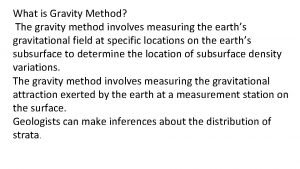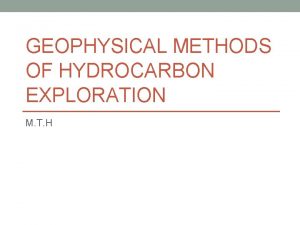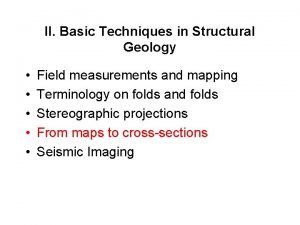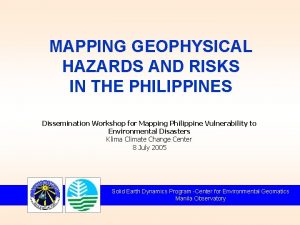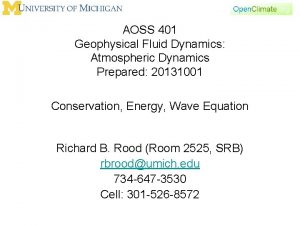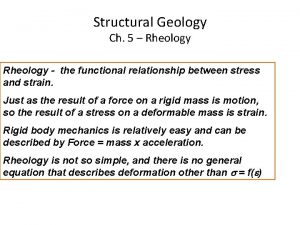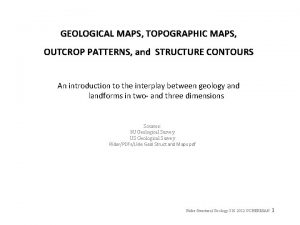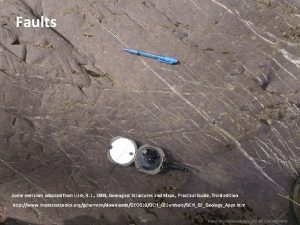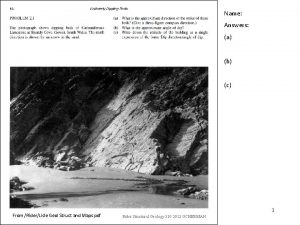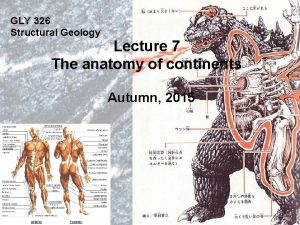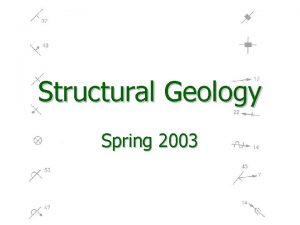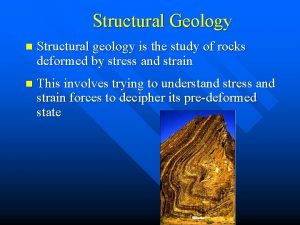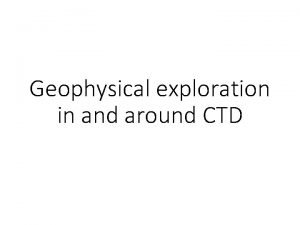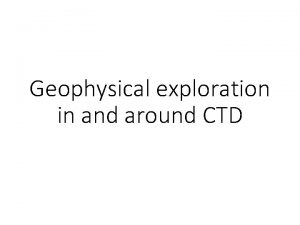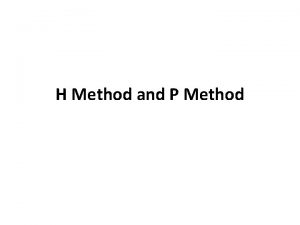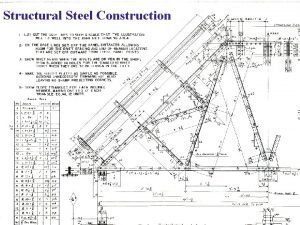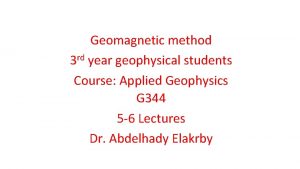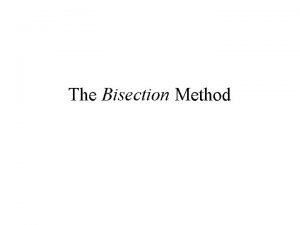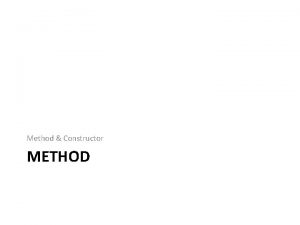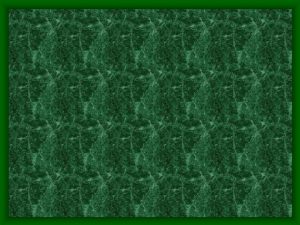STRUCTURAL GEOLOGY AND GEOPHYSICAL METHOD STRUCTURAL GEOLOGY The






















































- Slides: 54

STRUCTURAL GEOLOGY AND GEOPHYSICAL METHOD

STRUCTURAL GEOLOGY: � The branch of geology that deals with morphology, classification, mechanism and causes of development of these rock structure.

ATTITUDE OF BEDS �Three dimensional orientation or positioning of a given geological features, � such as a bed, �a joint, � a fold etc. ,

STRIKE: � When a bedding plane( OR joint plane / Fault plane) is cut by a horizontal plane, a line of intersection will be obtained at the surface. � This direction know as the strike. � Represented by N 30’E or S 30’W.

DIP: � The dip direction is the direction along which the inclination of the bedding plane occurs. � The dip amount is the angle of inclination between the bedding plane and a horizontal plane.

MEASUREMENT OF STRIKE AND DIP IN THE FIELD � The DIP and STRIKE of an exposed bed in the field can be measured in degrees by an instruments known as a CLINOMETER.


� The major structures formed within the rocks of igneous, sedimentary and metamorphic nature are folds, faults and joints.

FOLDS

FOLDS:

FOLDS: � Undulations or bends that are developed in the rocks of the earth crust, as a result of the stresses.

PARTS OF A FOLD 1. 2. 3. 4. 5. Limbs Axial plane Axis of the fold Crust and Trough Anticline and Syncline

� Limb - are the sides of the fold. � Axial plane – Imaginary plane bisecting between two limbs of a fold. Dividing the fold into two parts as symmetrically as possible. � Axis of the fold - line of intersection of the axial plane with any bed of the fold. � Crust and Trough- upfolded bends and down folded bends � Anticline and syncline – Convex upwards / downwards

TYPES OF FOLDS AND THEIR CLASSIFICATION: BASIS OF POSITION OF AXIAL PLANE symmetrical folds � Asymmetrical folds � Over turned folds � Recumbent folds � Isoclinal Folds � BASIS OF DEGREE OF COMPRESSION OF THE BEDS: Closed folds � Open folds � BASIS OF THEIR MODE OF OCCURRENCE: Anticlinorium and synclinorium Folds � Domes and Basins � BASIS OF THE POSITION OF FOLD AXIS: Non plunging fold � Plunging fold � BASIS OF THEIR BEHAVIOUR WITH DEPTH: Similar folds � Parallel folds � Supratenuous Folds �

�symmetrical folds �Asymmetrical folds �Over turned folds �Recumbent folds �Isoclinal Folds


BASIS OF THEIR MODE OF OCCURRENCE: �Anticlinorium �Domes and synclinorium Folds and Basins (Special type of anticline and syncline )

�Domes and Basins


BASIS OF THE POSITION OF FOLD AXIS: �Non plunging fold-Fold axis may horizontal �Plunging fold-Fold axis may be inclined

BASIS OF THEIR BEHAVIOUR WITH DEPTH:

CAUSES OF FOLDING 1. 2. Techtonic causes Non-Techtonic causes: - Lateral compression caused by shrinkage - Igneous instructions and - salt intrusions Non-Techtonic cause: - Land sliding - Creeping Differential compaction - Isostatic setting - Subsidence into solution cavities - Glaciation

ENGINEERING CONSIDERATION Fold

ENGINEERING CONSIDERATION �A civil engineer has to be very caution, While handling or excavating through the folded rocks, because whenever, the folds are disturbed, they release the stored energy and may damage the site in various ways. � Anticline folds provide good prospects for stored petroleum. � Fractured folded rocks are highly permeable, and pose numerous problem in dam construction.

FAULTS

�A Rock fracture or a fracture surface along which relative movement due to internal shearing stresses between the fractured parts occurs is called a fault.

A fresh fault scarp after an earthquake in Nevada. (S. Marshak)

i. iii. iv. v. viii. ix. Fault plane Fault trace or Fault outcrop or Fault line Dip and Strike of the fault. Hade Hanging wall and Foot wall Up-throw side and down throw side Throw. ( Total vertical displacement in a fault ) Slip and its types Heave ( Total horizontal displacement in a fault )

i. iii. iv. v. viii. ix. Fault plane Fault trace or Fault outcrop or Fault line Dip and Strike of the fault. Hade Hanging wall and Foot wall Upthrow side and down throw side Throw. ( Total vertical displacement in a fault ) Slip and its types Heave ( Total horizontal displacement in a fault )

i. iii. iv. v. viii. ix. Fault plane Fault trace or Fault outcrop or Fault line Dip and Strike of the fault. Hade Hanging wall and Foot wall Upthrow side and down throw side Throw. ( Total vertical displacement in a fault ) Slip and its types Heave ( Total horizontal displacement in a fault )

i. iii. iv. v. viii. ix. Fault plane Fault trace or Fault outcrop or Fault line Dip and Strike of the fault. Hade Hanging wall and Foot wall Upthrow side and down throw side Throw. ( Total vertical displacement in a fault ) Slip and its types Heave ( Total horizontal displacement in a fault )

i. iii. iv. v. viii. ix. Fault plane Fault trace or Fault outcrop or Fault line Dip and Strike of the fault. Hade Hanging wall and Foot wall Upthrow side and down throw side Throw. ( Total vertical displacement in a fault ) Slip and its types Heave ( Total horizontal displacement in a fault )

TYPES OF FAULTS AND THEIR CLASSIFICATION : � Basis of the apparent movement of the fault blocks: i) Normal fault normal fault dip More than 45’ ii) Thrust fault Hanging wall has apparently moved up with respect to the foot wall.

TYPES OF FAULTS AND THEIR CLASSIFICATION …… iii) Transcurrent fault or tear fault or transverse fault : It is that fault in which the blocks have moved against each other in an essentially horizontal direction. iv) Vertical fault:

TYPES OF FAULTS AND THEIR CLASSIFICATION …… � 2) Based on the amount of the Dip of the fault : i) High angle fault ( Fault plane dips more than 45’ ) Ii) Low angle fault (Fault plane dips less than 45’ )

� 3) Basis of the Attitude of the fault: i) Strike Fault plane is essentially parallel to the direction. ii) Dip fault strike of the Fault plane is essentially normal to the strike iii) Oblique fault strikes the beds neither parallel normally , but strikes obliquely or diagonally. 4) Basis of their mode of occurrence: i) Parallel faults ii) Radial faults iii) Enchelon faults iv) Step faults v) Peripheral faults vi) Horst and Garben

CAUSES OF FAULTING : � Faults are essentially the shear failure, resulting from tensional, compressional stresses acting on the crystal rock masses. � Normal faults of gravity faults – influence of horizontal tension. � Thrust faults – by compression stresses.

� Displacement not only in past, also that further fresh movements may take place at any time in future.


� Joints may be defined as cracks or fractures present in the body of a rock, along which there has been no relative movements as happen in the case of fault.

1. Geometrical classification: 1. 2. It is based on the attitude of the joints with respect to that of the beds. Strike joints Dip joints Oblique joints Genetic classification: Tension joints Shear joints


1. 2. 3. 4. 5. 6. Seismic methods Electrical methods Gravitational methods Magnetic methods Radio metric methods Geo thermal methods

� This method is based on the fact that seismic waves have different velocities in different types of soils (or rock) and besides the wave refract when they cross boundaries between different types of soils. � In this method, an artificial impulse are produced either by detonation of explosive or mechanical blow with a heavy hammer at ground surface or at the shallow depth within a hole.

� Seismic exploration in done by two methods`; 1. Refraction methods 2. Reflection methods � � Reflection methods are adopted for deep explorations ( depth not less than 100 m, usually more than 2 km ) of general geological importance or in oil explorations. Capable of substructure like anticlines, synclines, salt domes, fault, reefs, etc.

� Refraction methods are adopted for comparatively shallower explorations (from surface to several meters deep ). � For detecting Bed rock depth, fault zones, ground water, etc.



� Electrical resistivity method is based on the difference in the electrical conductivity or the electrical resistivity of different soils. � Resistivity is defined as resistance in ohms between the opposite phases of a unit cube of a material.



� To determine thickness of loose overburden bed rock at the foundation site. � To detect fractured or weak zones in the bed rock. � To locate dykes or veins in foundation rocks. � To know the attitudes (strikes and dips ) of rocks. � To detect structural defects like faults in the foundation site.

The Wenner configuration: This method was developed by Wenner in 1915. In this configuration, the outer electrodes, C 1 and C 2 are used to send current into the ground and the inner electrodes, P 1 and P 2 are used to measure the potential. The important feature of this setup is that the distance between any two successive electrodes is equal. The apparent resistivity measured in the Wenner method is given by Pa = 2πa(V/I) where � a = Electrode separation � v = Potential difference measured � I = Current sent into the ground � Pa = apparent resistance (ohm-mts ) �

 Gravity
Gravity Gravity method of geophysical exploration
Gravity method of geophysical exploration Kink method structural geology
Kink method structural geology National geophysical data center
National geophysical data center Reservoir geophysical corporation
Reservoir geophysical corporation Slidetodoc.com
Slidetodoc.com Geophysical fluid dynamics
Geophysical fluid dynamics Geology
Geology Geological outcrop map
Geological outcrop map Structural geology
Structural geology Orthographic projection geology
Orthographic projection geology Structural geology
Structural geology Structural geology
Structural geology Structural geology
Structural geology Objectives of symposium
Objectives of symposium Hát kết hợp bộ gõ cơ thể
Hát kết hợp bộ gõ cơ thể Frameset trong html5
Frameset trong html5 Bổ thể
Bổ thể Tỉ lệ cơ thể trẻ em
Tỉ lệ cơ thể trẻ em Chó sói
Chó sói Chụp phim tư thế worms-breton
Chụp phim tư thế worms-breton Hát lên người ơi
Hát lên người ơi Kể tên các môn thể thao
Kể tên các môn thể thao Thế nào là hệ số cao nhất
Thế nào là hệ số cao nhất Các châu lục và đại dương trên thế giới
Các châu lục và đại dương trên thế giới Công của trọng lực
Công của trọng lực Trời xanh đây là của chúng ta thể thơ
Trời xanh đây là của chúng ta thể thơ Cách giải mật thư tọa độ
Cách giải mật thư tọa độ Phép trừ bù
Phép trừ bù Phản ứng thế ankan
Phản ứng thế ankan Các châu lục và đại dương trên thế giới
Các châu lục và đại dương trên thế giới Thơ thất ngôn tứ tuyệt đường luật
Thơ thất ngôn tứ tuyệt đường luật Quá trình desamine hóa có thể tạo ra
Quá trình desamine hóa có thể tạo ra Một số thể thơ truyền thống
Một số thể thơ truyền thống Cái miệng xinh xinh thế chỉ nói điều hay thôi
Cái miệng xinh xinh thế chỉ nói điều hay thôi Vẽ hình chiếu vuông góc của vật thể sau
Vẽ hình chiếu vuông góc của vật thể sau Thế nào là sự mỏi cơ
Thế nào là sự mỏi cơ đặc điểm cơ thể của người tối cổ
đặc điểm cơ thể của người tối cổ Thế nào là giọng cùng tên?
Thế nào là giọng cùng tên? Vẽ hình chiếu đứng bằng cạnh của vật thể
Vẽ hình chiếu đứng bằng cạnh của vật thể Vẽ hình chiếu vuông góc của vật thể sau
Vẽ hình chiếu vuông góc của vật thể sau Thẻ vin
Thẻ vin đại từ thay thế
đại từ thay thế điện thế nghỉ
điện thế nghỉ Tư thế ngồi viết
Tư thế ngồi viết Diễn thế sinh thái là
Diễn thế sinh thái là Dot
Dot Số nguyên tố là số gì
Số nguyên tố là số gì Tư thế ngồi viết
Tư thế ngồi viết Lời thề hippocrates
Lời thề hippocrates Thiếu nhi thế giới liên hoan
Thiếu nhi thế giới liên hoan ưu thế lai là gì
ưu thế lai là gì Hươu thường đẻ mỗi lứa mấy con
Hươu thường đẻ mỗi lứa mấy con Sự nuôi và dạy con của hổ
Sự nuôi và dạy con của hổ Hệ hô hấp
Hệ hô hấp
